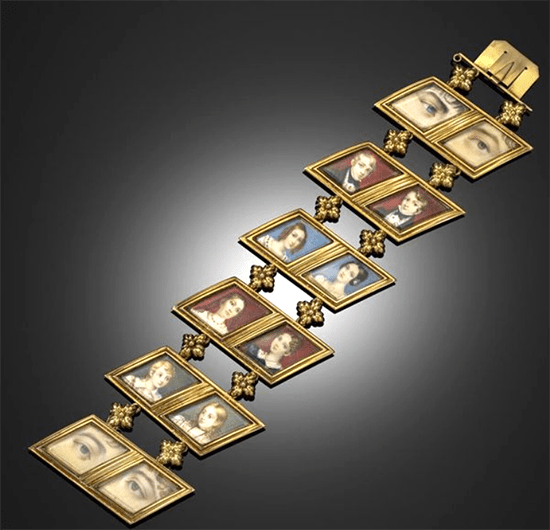Agapemone
Herein lies a tale of truth stranger than fiction. A fine high carat gold bracelet, circa 1830, articulated, with quatrefoil connectors. It is set with four evocative eye miniatures and eight further portrait miniatures. The miniatures depict members of the Nottidge family and the gold reverse is engraved with their names. One of the minatures is of Louisa Nottidge [1802 – 1858]. Louisa Nottidge was a woman whose incarceration in a lunatic asylum for disobeying her family’s wishes attracted widespread attention in the mid-19th century. The ensuant public outcry was exploited by author Wilkie Collins who published a best selling novel based on the theme, The Woman in White, in 1860.
Louisa came from a devout Christian family of wealthy wool cloth merchants. She had ten siblings. In 1843 the family chanced to meet a charismatic Revivalist preacher, Henry James Prince, who was preaching at a local church. When Louisa’s father died in 1844, his five unmarried daughters each received an inheritance of £6000. Prince persuaded the women to donate money to establish a religious cult in Somerset, to be called Agapemone [Abode of Love] after the Greek word for love – agapi. In 1845 three Nottidge sisters went to Somerset with a view to residing at Agapemone. En route Prince persuaded the three, Harriet, Agnes and Clara, to marry three clergymen from Agapemone. Prince then encouraged Louisa to join her sisters. Her mother Emily, horrified by the spiritual and financial influence Prince had over her daughters, instructed her son Edmund, her nephew Edward Nottidge, and her son-in-law, Frederick Ripley to go to Somerset and rescue Louisa. The three men succeeded in taking Louisa against her will in November 1846 and imprisoned her in Ripley’s Villa, Regent’s Park. Following Louisa’s claims about the divinity of Prince, her mother had her certified insane and she was incarcerated in Moorcroft House Asylum. Louisa escaped from the asylum in January 1848 and met Reverend William Cobbe from Agapemone, the brother of the campaigner Frances Cobbe.
Louisa was recaptured two days later at Paddington Station. Cobbe alerted the Commissioners in Lunacy whose report led to her release in May 1848. Louisa then sued her brother, cousin and brother-in-law for abduction and false imprisonment. She won the case with damages, proving that she had been illegally detained. Louisa returned to Agapemone, transferred her wealth to Prince and remained there until her death in 1858. These extraordinary events in Louisa Nottidge’s life remain pertinent today – the rights of psychiatric patients, women’s rights and the conflict between freedom to practise religion and the law.
Truth really is stranger than fiction.
sold





The cult at Agapemone

Agapemone in Somerset

